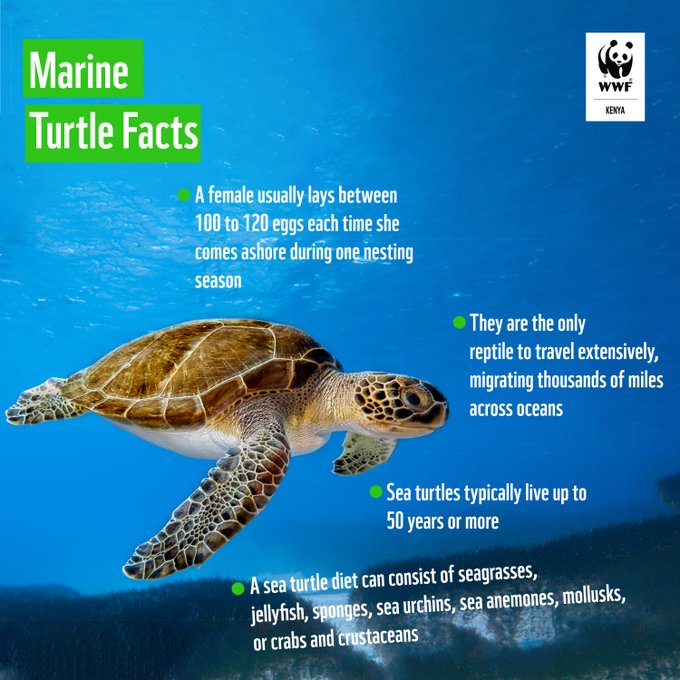NAIROBI, Kenya – Sea turtle populations have exhibited signs of recovery in the majority of their geographical locations, according to a recent global survey published in the Endangered Species Research journal. In Belize, this picture shows a loggerhead turtle swimming. It is classified as vulnerable.
The study measured the effects of threats on 48 species of sea turtles worldwide. Overall, dangers are decreasing in over half of the places that were investigated.
Sea turtles often live between 50 and 100 years in the wild. The US Endangered Species Act of 1973 protected them, although population conservation took several decades.
Human activity has tipped the scales against these ancient mariners’ survival throughout the past 200 years. Sea turtles are killed for their meat, eggs, skin, and shells, and they are overfished due to poaching. They also have to deal with habitat loss and bycatch, or unintentional capture with fishing gear.
Fishing methods have the potential to disturb sea turtles’ habitats and food supplies in addition to causing bycatch. One of the biggest hazards to sea turtles is sea turtle mortality in fisheries, which is also thought to be the main reason for many population declines.
An estimated 150,000 turtles of all species are killed in shrimp trawls, over 200,000 loggerheads and 50,000 leatherbacks are seized, maimed, or killed by longlines, and numerous turtles of all species drown in gill nets each year. These figures are astounding.
Did you know? Sea turtles can live for decades, with some species reaching up to 80 years or more. They have remarkable navigational abilities, often traveling thousands of kilometers across oceans but returning to the same beach where they were born to lay their eggs.
Against this backdrop, Y News looks at the seven species of sea turtle; each one is a wonder in its own right, playing a vital role in the health of our oceans. Now, let’s dive deeper and get to know each one of them a little better!
Leatherback Sea Turtle:
The largest of all sea turtles and indeed one of the largest reptiles on earth, the Leatherback is unique for its leathery shell. Unlike other sea turtles, leatherbacks don’t have hard, bony shells. Instead, their carapace is flexible and rubbery, which is an adaptation for deep diving.
Green Sea Turtle:
Named not for the colour of its shell but for the greenish colour of its fat, the Green Sea Turtle primarily feeds on seagrasses and algae, which contribute to the colour of their fat. They’re found in tropical and subtropical waters around the world.
Loggerhead Sea Turtle:
Known for their large head and powerful jaw, Loggerheads use these features to crunch on hard-shelled prey like crabs and sea urchins. They are widely distributed throughout the world and are named for their exceptionally large heads.
Hawksbill Sea Turtle:
With a distinctive bird-like beak, Hawksbills are perfectly adapted to finding food from crevices in coral reefs. They are known for their beautiful and colourful shells, which unfortunately make them a target for illegal wildlife trade.
Flatback Sea Turtle:
Named for its uniquely flat shell, the Flatback Sea Turtle is mostly found in the waters around Australia. Unlike other sea turtle species that have a more domed shell, flatbacks have a shell that is, well, flat!
Olive Ridley Sea Turtle:
One of the smallest sea turtles, the Olive Ridley is known for its olive-coloured shell. These turtles are famous for their mass nesting events, known as ‘arribadas,’ where thousands of females come ashore together to lay their eggs.
Kemp’s Ridley Sea Turtle:
The smallest and the rarest of all sea turtles, Kemp’s Ridleys are critically endangered. They also participate in mass nesting events similar to the Olive Ridleys.
More information about the sea turtles
Sadly, all seven species of sea turtles are considered threatened or endangered to varying degrees according to the International Union for Conservation of Nature (IUCN) Red List. The specific classification can vary from vulnerable (like the Olive Ridley) to critically endangered (like the Hawksbill and Kemp’s Ridley).
Marine turtles are truly remarkable creatures with some fascinating traits. A female can lay between 100 to 120 eggs during each nesting season when she comes ashore. These ancient reptiles are also the only ones to travel such vast distances, migrating thousands of miles across
Y News understands that sea turtles are crucial to our oceans’ health. They contribute to nutrient cycling by enriching beach soil with their unhatched eggs.
They help maintain balanced food chains and marine ecosystems by controlling jellyfish populations.
Additionally, certain species like Green Sea Turtles support the growth of seagrass beds, and Hawksbills contribute to the health of coral reefs by eating sponges that compete with slow-growing corals. In all these ways, sea turtles help keep our oceans thriving.




